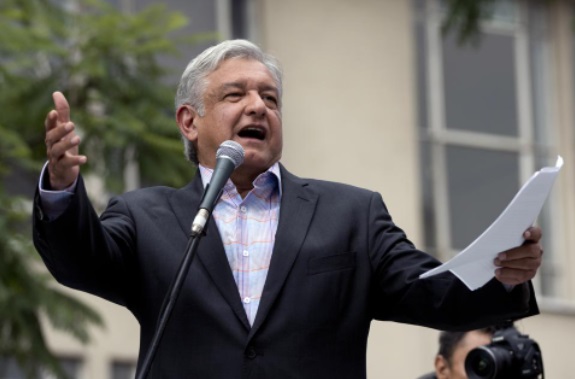
(Forbes, 28.Apr.2022) — An ambitious effort to definitely steer Mexico back to a statist energy future was narrowly defeated this last week, leaving its energy sector still officially open to the private sector but largely unattractive to all but the most speculative investors.
More than half of Mexico’s lower chamber of the Congress voted for the bill, which would have guaranteed 54% of Mexico’s electricity market for state-owned Federal Electricity Commission, or CFE, regardless of cost.
The vote falls short of the two-thirds majority required by Mexican law for a constitutional law change. Yet it speaks volumes about the significant level of support that President Andres Manuel Lopez Obrador has had in his campaign to return the energy sector back to state hands.
This support – and Lopez Obrador’s popularity in doing so – reflects the huge disconnect many Mexicans have about the supposed benefits of a more efficient energy sector and their own lives.
The argument of Lopez Obrador’s Morena party is that foreign investment in energy is a form of exploitation, with essentially no benefit for most Mexicans.
“Citizens will pay attention to who votes for national sovereignty and who defends the interests of the transnational companies,” said the president’s spokesperson, Jesús Ramírez Cuevas, prior to the vote. “The homeland comes first!”
These comments are similar to those made by Lopez Obrador, who came into power in 2019 with broad popular support. He campaigned on his desire to return Mexico’s state-owned energy sector back to its central position, rather than encourage the development of a competitive private sector.
His main obstacle has been the 2014 ‘Energy Reform’ – as it is known in Mexico – that fully opened up the sector to international private competition. While Mexico had permitted some private investment in electricity – large companies were allowed to generate renewable power for their own use, for example – the 2014 laws established a wholesale power market and attempted to dismantle the CFE monopoly.
This opening was supposed to be the jewel in the crown of Mexico’s most powerful political party, which had been voted back into power after a 12-year hiatus. The Institutional Revolutionary Party, or PRI, had had uninterrupted control over Mexico from shortly after its revolution in 1929 until 2000.
Yet the 2014 opening of the sector fell short of public expectations that gasoline and power prices would immediately go down. Instead, formerly subsidized gasoline prices rose about 50% at the same time that private service stations began to the dot the country. President Enrique Pena Nieto, the public face of the energy reform, became a focal point of derision for his involvement in several corruption scandals, and for a complete failure of leadership in the disappearance of 43 students.
The combination of PRI corruption and its active involvement in the energy reform made Lopez Obrador’s campaign message of energy nationalism, anti-corruption and economic empowerment a compelling one for Mexican voters. He won with a plurality – almost unheard of in the three-way race – and hit an 80% approval rating soon after taking office.
Over last three years, Lopez Obrador has tried to dismantle the private electricity sector, including the cancellation of auctions, the removal of key regulations and new laws that handicap the existing companies. He has had some pushback from the private sector and from Mexico’s courts, as companies have challenged the legal constitutionality of especially aggressive measures.
Lopez Obrador has only been partially successful, but he has demonstrated that it is possible to undermine the private sector for all practical purposes. A recent Supreme Court decision, for example, failed to block a 2021 law that favors the CFE.
It also reflects the indifference of the majority of Mexican voters in who controls the energy sector, even if a return to state control will mean impending brown outs, a less competitive manufacturing sector and stagnant economic growth.
And, after more than three years in office, Lopez Obrador has one of the highest public approval levels of any Mexican president in the last three decades. And while his current 58% approval is considerably lower than the 76% he entered office with, it is still a clear majority.
The approval has been marketed by Lopez Obrador as an indication of public support for his statist policies in the energy sector.
“More than 15 million Mexicans are happy and want me to continue until September 2024,” Mr. López Obrador said in a video message following a referendum vote that he had engineered to demonstrate his broad support. “We are going to continue with the transformation of our country.”
Instead, Lopez Obrador’s support has been solid in Mexico, even as he has pushed to replace private “neo-imperialist” renewable energy projects with more state-owned diesel oil and natural gas plants.
The economic disparity in Mexico can help explain why many Mexicans don’t see a competitive energy sector as having any relationship to their own economic well-being. Mexico has close to the world’s average per capita income, yet half of its population lives in grinding poverty.
And despite the promises of how the North American Free Trade Agreement would transform the lives of Mexican workers, these numbers have not budged in the last three decades. And they look even worse compared to previous decades. From 1960-1980, Mexican real GDP per person almost doubled. In the past 20 years it has grown by just 18.6 percent, according to the Center for Economic and Policy Research.
Indeed, in Pena Nieto’s six-year stint in office, the Mexican daily minimum wage only increased from roughly $3 to $4. And the low wages have been repeatedly justified by Mexican businesses and government officials who argue this is how Mexico can compete in the international market.
Under Lopez Obrador, who shows no great interest in Mexico’s international position, the minimum wage has doubled. A token gesture? Perhaps, but it is a visible one, while talk of future economic benefits from more competitive manufacturing sound mostly esoteric to those working six days a week on factory lines, trying to feed their families by producing goods that they cannot afford.
The resulting cynicism about the private market is understandable but sad, given that the Energy Reform seemed to offer something for everyone, especially Mexicans on a budget.
At the time, citizens were told the billions of investment dollars it was going to draw would modernize Mexico’s electricity sector. It would make up much of the $10 billion-a-year investment in the electricity sector that Fitch Ratings estimates will be needed to keep up with Mexico’s growing demand. This investment would both bring down prices and enable Mexico to harness its tremendous renewable resources. It would attract private investment into wind and solar farms, while weaning the country off its state-run coal and diesel power plants.
This should have been welcome news to Mexicans, given its persistent struggles with air pollution related to fossil fuels, particularly in Mexico City. The diesel oil fueling an electrothermal plant in Tula, for example, spews sulfur pollution at twice the rate of what Mexico’s own lax environmental laws allow.
Yet given the time it takes to phase out plants like Tula, and that Mexico’s subsidized residential electricity rates stayed about the same they had always been, connecting the dots and its impact on ordinary Mexicans has been a tough sell and has given an opening for Lopez Obrador’s populist message.
The good news in all of this is that Mexico’s laws encouraging a private sector are still in place, and Mexico’s next presidential election is only two years off. The two most likely successors to Lopez Obrador, Claudia Sheinbaum and Marcelo Ebrard, both have shown more interest in renewable power.
And support for Lopez Obrador should not obscure the fact that Mexicans would be delighted to embrace a future of healthy air and a vibrant economy. But next time, the tide will need to show how it can lift all economic ships, if it is going to get their support.
____________________
By Emily Pickrell, UH Energy Scholar
Emily Pickrell is a veteran energy reporter, with more than 12 years of experience covering everything from oil fields to industrial water policy to the latest on Mexican climate change laws. Emily has reported on energy issues from around the U.S., Mexico and the United Kingdom. Prior to journalism, Emily worked as a policy analyst for the U.S. Government Accountability Office and as an auditor for the international aid organization, CARE.

